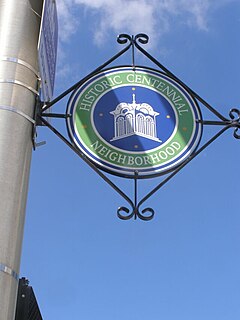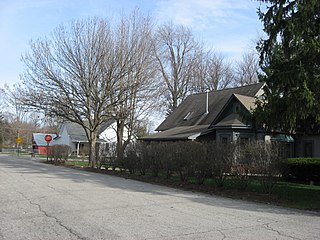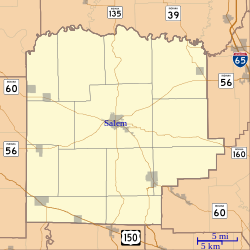
The Salem Downtown Historic District is a national historic district located at Salem, Washington County, Indiana. The original plat of the town, founded in 1814, is within the district. It is bounded by Mulberry and Hackberry Street in the north, Hayes Street in the east, the CSX railroad tracks in the south, and Brock Creek to the west. It encompasses 253 contributing buildings, 3 contributing structures, and 5 contributing objects in the central business district of Salem. The district was placed on the National Register of Historic Places in 1997. Its architectural styles are Italianate, Gothic Revival, Classical Revival, Late Victorian, Early Republic, and Late 19th/20th Century Revivals.

Salem's Baptist Church is a historic Baptist church located at 728 Court Street in downtown Evansville, Indiana. It was built in 1873, and is representative of Prairie School architecture.

The Big Run Baptist Church and Cemetery, also known as Franklin Township Historical Society, is a historic Baptist church and cemetery located at 6510 South Franklin Road in Franklin Township, Marion County, Indiana. The church was built in 1871 as a Baptist meeting house and served the church congregation until 1977. It is a one-story, gable front brick building with Italianate style design elements. The associated cemetery was established in 1854, with one stone dated to 1841. The most recent burial was in 1986. Also on the property is a contributing privy constructed about 1920. The Franklin Township Historical Society acquired the property and now uses the building as a historical museum.

Hope Historic District is a 114-acre (46 ha) national historic district located at Hope, Bartholomew County, Indiana. It encompasses 205 contributing buildings, four contributing sites and two contributing objects in the central business district and surrounding residential areas of Hope. It was developed between about 1840 and 1940, includes works by architect Elmer E. Dunlap and by L.W. Weisner, and notable examples of Greek Revival, Italianate, Hall and parlor, and other architecture. Notable buildings include the Moravian Church (1875) and old parsonage (1875), City School (1906), Baptist Church, Methodist Episcopal Church (1887), Alfred Sanford Rominger House, Frank Stapp House, Masonic Temple (1910), and E.B. Spaugh Building (1915).

First Baptist Church is a historic Baptist church located at 309 E. Adams Street in Muncie, Indiana. The Late Gothic Revival building was designed by Samuel Hannaford & Sons and constructed in 1928-1929 by Morrow & Morrow. It is constructed of Indiana limestone and has a cruciform plan. It features and engaged five-story tower.

The First Baptist Church is a historic Baptist church located at Elm and Sinclair Sts. in West Baden Springs, Indiana. It was built in 1920, and is a one-story, rectangular, vernacular Late Gothic Revival style frame building. It features a square projecting belfry. At the time of its listing, the property was then vacant, and was owned by the West Baden Historical Society. It was deemed significant in the area of "Ethnic heritage: Black".

The Liberty Baptist Church is a historic African-American Baptist church located at 701 Oak St. in Evansville, Indiana. It was founded in 1865 as a congregation of former slaves, according to Historic Evansville. The Gothic Revival red brick church was built in 1887, as a replacement after a cyclone destroyed an earlier building.

Centennial Neighborhood District is a national historic district located at Lafayette, Tippecanoe County, Indiana. The area originated as the Bartholomew and Davis Additions to Lafayette in 1829. Growth came rapidly after the Wabash and Erie Canal arrived in 1843. Growth continued with the arrival of the railroad in 1853. The Centennial Neighborhood Historic District takes its name from the Centennial School, which was constructed in 1876 on the centennial of the nation. The school was located on the north east corner of Brown Street at North 6th Street. The school has been removed and a park created at its original location.

Dutch Ridge Historic District is a national historic district located in Perry Township, Allen County, Indiana. The district encompasses two contributing buildings and one contributing site in Perry Township. They are the Perry Township District School #1, or Dutch Ridge School (1888) with Queen Anne style design elements and the Late Gothic Revival style Salem Reformed Church (1876). Also located in the district is the Dutch Ridge Cemetery.

Elston Grove Historic District is a national historic district located at Michigan City, LaPorte County, Indiana. The district encompasses 215 contributing buildings and 1 contributing structure in a predominantly residential section of Michigan City. It developed between about 1860 and 1963, and includes examples of Italianate, Greek Revival, Queen Anne, Colonial Revival, and Bungalow / American Craftsman style architecture. Notable buildings include the A.J. Henry House, Kubik Doctors Office (1953), Manny House (1902), Haskell-Boyd House, Moritz House (1911), Zorn Brewey, Petti Grocery, Luchtman Building, Dr. Ginther House (1940), Sherman Apartment Building (1921), First Baptist Church (1914), the Public Library (1896-1897), and the Adventist Church - Christian Science Church.

Second Baptist Church is a historic Baptist church located at Bloomington, Monroe County, Indiana. It was designed by noted African-American architect Samuel Plato and built in 1913. It is a one-story, "L"-plan, Romanesque Revival style stone building on a raised basement. It features broad round arched openings, a two-story bell tower, lancet windows, and oculus tracery.

Bloomington West Side Historic District is a national historic district located at Bloomington, Monroe County, Indiana. The district encompasses 394 contributing buildings, 2 contributing sites, and 2 contributing structures in a mixed residential, commercial, and industrial section of Bloomington. It developed between about 1850 and 1946, and includes notable examples of Queen Anne and Bungalow/American Craftsman style architecture. Located in the district are the separately listed Elias Abel House, Cantol Wax Company Building, Coca-Cola Bottling Plant, Cochran-Helton-Lindley House, Illinois Central Railroad Freight Depot, Johnson's Creamery, and Second Baptist Church. Other notable contributing resources include the Works Progress Administration constructed wading pool, White Oak Cemetery, Ninth Street Park, Bloomington Wholesale Foods Warehouse, Bloomington Garage, Curry Buick, Banneker School, Bethel African Methodist Episcopal Church, and Bloomington Frosted Foods.

Ellettsville Downtown Historic District is a national historic district located at Ellettsville, Monroe County, Indiana. The district encompasses 50 contributing buildings in the central business district and surrounding residential sections of Ellettsville. It developed between about 1840 and 1953, and includes notable examples of Queen Anne, Early Commercial, Gothic Revival, and Bungalow/American Craftsman style architecture. Notable buildings include the Robert Stimson House, May Presley House, Bradford House, George W. Fletcher House, Wickens House (1909), Capt. Gilbert Perry House, I.O.O.F. Building, Town Hall (1927), Masonic Building (1895), Knights of Pythias Building, First United Methodist Church (1900), and First Baptist Church (1909).

St. George Lutheran Church is a historic Lutheran church located in Jackson Township, Shelby County, Indiana.

Shelbyville Commercial Historic District is a national historic district located at Shelbyville, Shelby County, Indiana. The district encompasses 149 contributing buildings, 1 contributing site, and 2 contributing objects in the central business district of Shelbyville. It developed between about 1822 and the 1930s, and includes notable examples of Italianate, Second Empire, Beaux-Arts, Classical Revival, and Art Deco style architecture. Notable contributing resources include the Shelbyville Central Schools Administrative Offices (1912), Carnegie Library (1902), First Baptist Church (1903), St. Joseph Catholic Church and School (1908), Civic Center (1932), Melton Jewelry Store (1886), Blessing-Deprez Building (1869), Knights of Pythias (1901), Cherry Building (1889), I.O.O.F. Building (1895), Old High School Building (1886), and a statue of Charles Major (1929).

Dayton Historic District is a national historic district located at Dayton, Indiana,, Tippecanoe County, Indiana. The district encompasses 82 contributing buildings and 1 contributing site in the central business district and surrounding residential sections of Dayton. It developed between about 1830 and 1952 and includes representative examples of Greek Revival, Italianate, Second Empire, and Bungalow / American Craftsman style architecture. Notable contributing resources include the Lantz Building (1941), Reincke-Hawkins House, Castle Block (1894), Baker-Yost House, First Presbyterian Church (1899), and Gladden-Goldsbury House.
West Lafayette Baptist Church (1898-1964), also known as Church of the Good Shepherd (1964-1976), was a historic Baptist church located at West Lafayette, Tippecanoe County, Indiana. It was built between 1898 and 1901, and was a two-story, cross shaped Gothic Revival style brick building. It featured a corner bell tower with three-tiered masonry buttresses. The Cynthia Jones Hall was added in 1936-1937 and the church was remodeled in 1951.

Columbia City Historic District is a national historic district located at Columbia City, Whitley County, Indiana. The district encompasses 197 contributing buildings in the central business district and surrounding residential sections of Columbia City. It developed between about 1840 and 1937 and includes representative examples of Greek Revival, Italianate, Queen Anne, Second Empire, Classical Revival, and Bungalow / American Craftsman style architecture. Located in the district is the separately listed Whitley County Courthouse. Other notable contributing buildings include the former Whitley County Courthouse (1841), Adams Y. Hooper Residence, Thomas Shorb Residence, William McNagny Residence, Elisha L. McLallen House (1905), Whitley County Jail (1875), City Hall (1917), Peabody (Carnegie) Library (1919), U.S. Post Office (1935), Central Building (1872), D.B. Clugston Block (1889), Masonic Temple (1904), Church of the Brethren (1889), Presbyterian Church (1892), Methodist Church (1912), and Baptist Church (1917).

New Augusta Historic District is a national historic district located at Indianapolis, Indiana. It encompasses 114 contributing buildings, 1 contributing structure, and 1 contributing object in a railroad oriented village in Indianapolis. The district developed between about 1852 and 1939, and includes representative examples of Italianate and Bungalow / American Craftsman style architecture. Notable contributing buildings include the Odd Fellows Building, Hopewell Evangelical Lutheran Church, Salem Lutheran Church (1880), and New Augusta Depot. It is located west of Augusta.

Cumberland Historic District is a national historic district located at Cumberland, Indiana. It encompasses 91 contributing buildings in the Cumberland section of Indianapolis. The district developed between about 1831 and 1950, and includes representative examples of Folk Victorian and Bungalow / American Craftsman style architecture. Notable contributing resources include the Cumberland Bank (1907), Masonic Lodge, Miller's Lunch, and First Baptist Church (1912-1913).
























